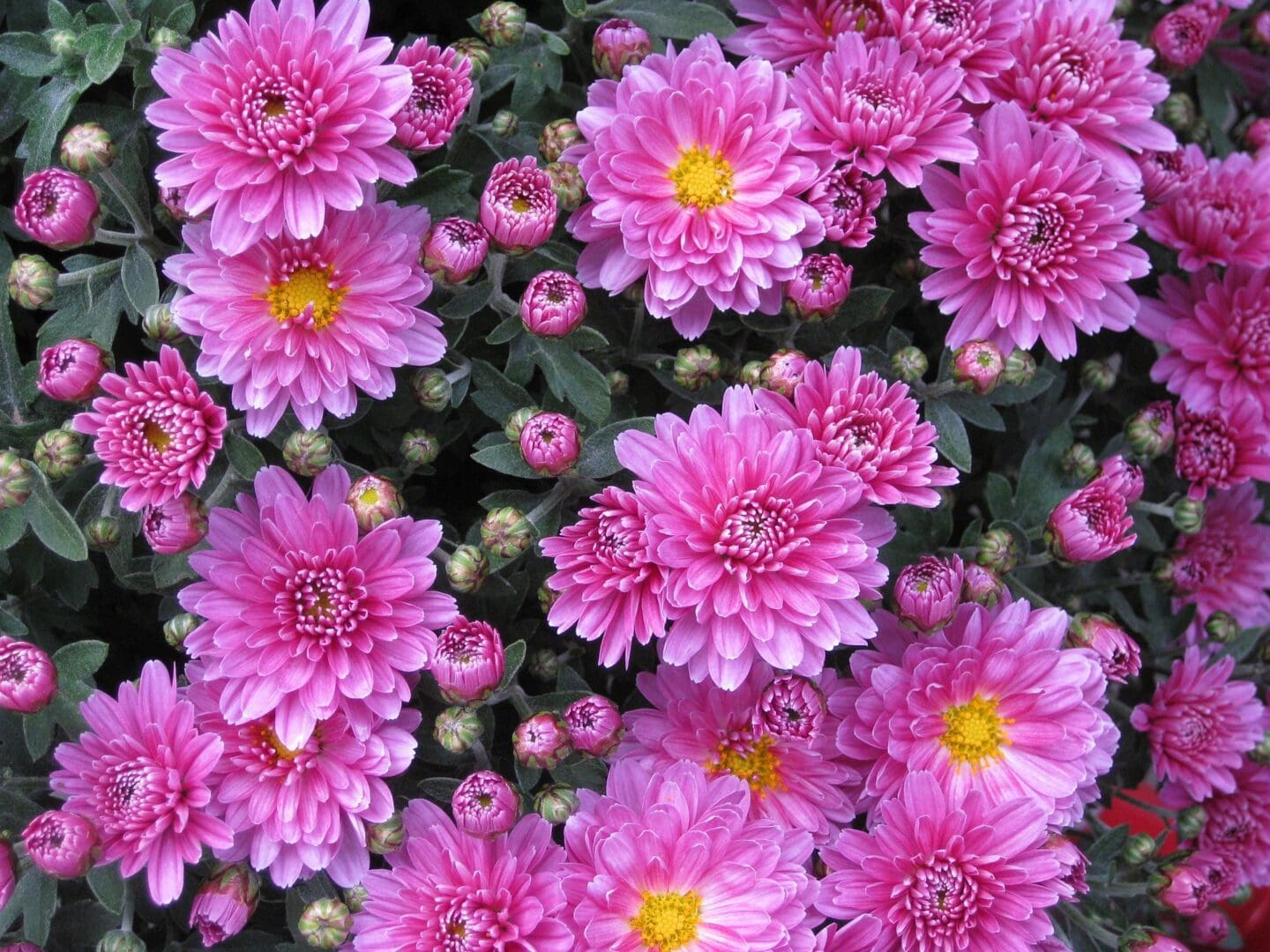
Garden Mums
Nearly every season is garden mum season at Bennett’s. In spring, summer, and fall we carry over 55 varieties of yellow, gold, bronze, purple, white and red cushion mums. Mums are great for vibrant fall color and can be planned to offer color for many weeks.
Cushion mums are a specific type of mum that will bear flowers close to the foliage and remain short and compact. This hardy type of mum should not be confused with florist mums. Florist mums are often hardy plants, but they have certain light requirements. The natural outdoor day length in the Midwest does not allow these mums to flower the second year.
The cushion mums we sell are termed “hardy†or “garden†mums. These varieties were termed “hardy†until 1982, when the name was changed to “garden†throughout the industry. This change reflects the grower industry’s concern with the problem of winter survival that many customers’ experience, thus the name “garden†mum denoted this hardiness problem. Regardless of the name change, we at Bennett’s feel these mums can survive many of our Indiana winters. Following the guidelines in this brochure will provide the best conditions for survival. Our varieties have been specially selected for hardiness as well as beauty.
There are many factors affecting how mums do their first year as well as future hardiness. These include the location selected for planting, the method of planting, watering practices, pruning, fertilization, and winter protection. If our suggestions are followed, we feel the probability of mums living through the winter is greatly enhanced. You will also be able to enjoy a compact, bushy, deep green plant that offers long lasting and profuse flowers.
Selection
In selecting a mum there are several factors to consider. First, remember mums are true perennials and will only bloom for 4 to 6 weeks. When selecting a mum in the fall, think of when you need its color. A plant with tight buds should be in full bloom in a month and last at least 4 to 6 more weeks. A mum bought in full bloom in August will only last about 4 more weeks until mid-September.
Different varieties of mums will bloom at different times. If planted together early, mid, and late season varieties will give continuous color from August through November. Choosing early blooming varieties of mums will provide fall color from mid-August to mid-September. Mid-season mums bloom from September 1st through October 1st. Late season mums bloom from the middle of September through November.
The second step in selecting a mum is the health of the plant. Look for dark green foliage and a compact bushy plant. Also check the leaves for evidence of disease and insects.
A third step is selection of blossom type. Many types of blossoms are available. These include the regular double flowered types and different spider, button, fugi, daisy, and pompom flowers.
Location
For the fullest and greenest mum, always choose a sunny location for your plant. A minimum of 5 hours of sunshine is required for optimum growth. Less than 5 hours of sun will result in a smaller, leggy plant with fewer blooms.
Planting
Planting your mum correctly is the most important step. The hole should be dug about twice the diameter of the pot and 3 to 4 inches deeper. In the case of a Bennett’s mum this would mean approximately 12†wide by 10†deep. The soil that is removed should be mixed with equal parts of sphagnum peat moss and this mixture will be used to fill in the hole.
Remove the mum from the pot with a quick tap, then place it in the hole so that it will be planted 3 to 4 inches deeper than it was in the pot. This will help establish the root system deeper to resist drying and winter thawing. The stems that are buried will also sprout roots, thus helping to make a stronger plant.
Backfill about 3/4 of the hole with the peat and soil mix. Pack lightly to remove air pockets. At this time a starter fertilizer should be used. We suggest a liquid root stimulator or a slow release planting tablet. Fill the remaining hole with water and allow draining. After the water has been absorbed, finish filling the hole with soil mix. DO NOT PACK SOIL AT THIS TIME. Water thoroughly again to insure the soil is settled in around the roots. These two waterings will settle the soil and help insure the roots to receive ample water to relieve transplant shock.
Watering
It’s very important to keep mums well watered the first two weeks after planting. Water thoroughly every second day or whenever the plant looks wilted. Place your garden hose around the planting hole for 5 to 10 minutes and allow water to slowly soak in around the roots. All watering should be done as a supplement to normal rainfall. A thorough watering whenever dry is much more beneficial than watering 2 to 3 minutes every day. The roots are forced to grow deeper looking for water. A strong, deep root system insures a much hardier plant.
Pruning
Mums require pinching to ensure a compact, full plant. In the Midwest, garden mums will naturally set buds anytime after mid-May for flowering about 4 to 6 weeks later. So, pinch no later than July 4 for blooms in August. In the spring allow the mum to grow to 6†tall then prune to 3â€. Continue pruning 2 to 3 inches off of each new 6†growth until July 4th.
Fertilizing
Mums need fertilizer for strong foliage growth and good root development. Fertilizer will also promote blossoms and keep them lasting longer. We suggest you fertilize throughout the spring, summer and fall. Use a water-soluble fertilizer, Fertilome Blooming & Rooting or Miracle-Gro, every other time you water, or use a granular garden type fertilizer as a top dressing around the mum at least once a month. This is an important step in developing a strong healthy plant. Fertilizing would not have to be done to an established plant, but if done it will produce a much nicer plant.
Fall & Winter Care
A flowering mum should remain full of color approximately 4 to 6 weeks. When flowering has ceased, remove dead blooms. Allow the foliage to remain until it is time to prepare them for winter.
Around Thanksgiving it is time to provide some winter protection for your mum. Cut the plant back to 2-4 inches and cover it completely with sphagnum peat moss then water thoroughly. Many people use leaves, straw or soil as a mulch, but we strongly recommend sphagnum peat.
Future Care
In the spring, after the danger of frost is past, remove the peat moss mulch. Remove any dead stems at this time. If the plant survived the winter, short green shoots of new growth should be seen by May 1. A conscientious effort to provide this care will result in a lifetime enjoyment of mums.
We at Bennett’s are here every day to give “Helping Hand Hints†personally, one to one. Many gardening problems are very specific, and we couldn’t possibly cover all aspects in these pamphlets. Any time you have a specific problem or need help, feel free to call. It’s our job to help you be successful in your growing endeavors, and we thoroughly enjoy giving you a “helping hand.â€
BENNETT’S
3651 McCarty Lane
Lafayette, IN 47905
Phone: (765) 447-7636
[email protected]
www.bennettsgreenhouse.com
